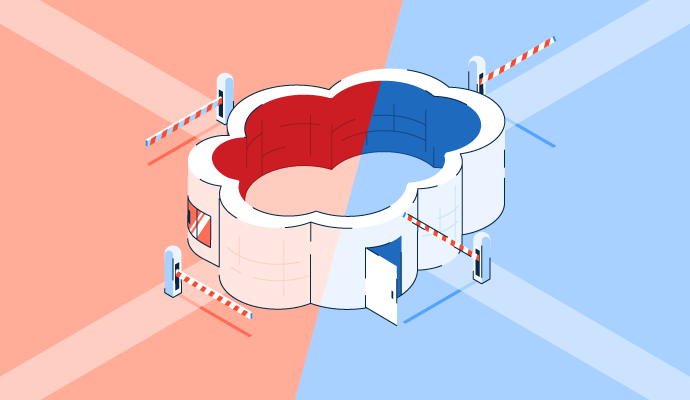December 20, 2024
 by Alyssa Towns / December 20, 2024
by Alyssa Towns / December 20, 2024

As modern businesses continue to embrace the cloud, the challenge of securing sensitive data and maintaining compliance steadily becomes more involved and complex.
Cloud access security brokers (CASBs) and security service sdge (SSE) are designed to bolster cloud security, but you may not know how to choose between them. Understanding their differences in scope and structure can help you make a well-informed decision to guide your cloud security strategy. But first, let’s examine CASB vs. SSE: What can they do and where they sit in the cloud security landscape in relation to one another?
CASBs are specialized tools that enforce security policies between employees and cloud-based resources. They concentrate on managing access, protecting data, and remaining compliant within cloud environments.
SSE provides a unified security framework that integrates protection for cloud services, web traffic, and private applications.
CASB is one of the core components of SSE. Both solutions enhance cloud security.
Organizations have the option of setting up CASB software alone or as part of an overarching SSE strategy.
CASB refers to on-premises or cloud-based security policy enforcement between cloud service providers and their consumers. These points enable organizations to inject their enterprise-wide security policies as employees access cloud-based resources.
CASB reduces the risks associated with cloud applications and network connections. The software also allows organizations to identify abnormal use patterns that may signal noncompliant behaviors.
CASB’s four pillars help organizations extend their security control to cloud-based services.
Two of the primary benefits of CASB entail providing comprehensive visibility of cloud usage and safeguarding sensitive business information. CASBs equip IT teams with monitoring and management capabilities that can uncover potential security threats, such as an employee using an unauthorized application. Additionally, CASBs help protect data in transit and at rest with encryption, tokenization, and data loss prevention (DLP) features.
Despite their valuable advantages, CASBs present some limitations worth considering. As StrongDM explains, integrating a CASB with an organization’s existing IT infrastructure is complicated. “The main limitation of a CASB solution is integrating it with the rest of your organization’s standalone security solutions. Each additional cybersecurity solution increases the complexity (and subsequently the cost) of managing security since every security solution must be acquired, provisioned, monitored, and maintained separately.”
CASB pricing also raises concerns for some organizations. The cost for these tools depends on the range of services included and the type of access that’s beingbrokered. Many CASB pricing models comprise annual licensing plus per-user cost, which is why larger organizations may feel some budgetary strain. However, IBM put the global average cost of a data breach in 2024 at $4.88 million, so it’s worth weighing the risks of a data breach against the price of CASB solutions.
CASB offers several key features to enhance cloud security:
Security service edge is a broad security framework that secures access to the web, cloud services, and private applications. It encompasses a wide range of protection capabilities, like access control, data security, monitoring, and acceptable use policies. In most cases, SSE is a cloud-based service, but it can also include on-premises elements.
The security service edge is a subset of the security access service edge (SASE). SSE combines security services such as secure web gateways (SWGs), firewall as a service (FWaaS), zero-trust network access (ZTNA), and CASBs. SSE comprises part of the SASE framework as shown below:
Think about SSE as a unified security platform that brings together various security functions into a single service model. The core capabilities or services of SSEare explained.
Together, these services and solutions enforce policy control, detect threats, and prevent attacks across the web, cloud services, and private applications.
One of SSE's primary benefits is its ability to manage security through a single platform. This integration simplifies deployment in order to provide a cohesive solution that businesses can adapt to their unique environments.
SSE’s scalability and flexibility also impress users. As organizations adopt cloud-based applications and services, traditional on-premises security solutions struggle to keep pace. Since SSE is usually a cloud-based service, it readily accommodates growing data needs and supports distributed workforces.
While SSE consolidates many security platforms, it doesn’t offer complete protection. Firewall.cx says that “nonuser traffic, malicious traffic, and wide-area network (WAN) malware propagation are not considered. A 360° approach to SSE, which provides advanced threat protection for east-west and north-south traffic, is required to counter this.”
Determining whether to use an all-in-one solution for all SSE technologies or a combination of individually integrated tools can also affect the success of an SSE implementation. Some teams may struggle if they don’t have an approach that best suits their organization.
CASB and SSE are both critical when it comes to cloud security. Understanding their differences helps clarify how to use them.
|
CASB |
SSE |
|
|
High-level definition |
Security solution designed to safeguard cloud applications and data access while providing visibility into application usage |
Unified cloud-native security framework that focuses on securing access to cloud services, the web, and private applications, one piece of the SASE framework |
|
Scope |
Focus on cloud applications |
Encompasses functions across web access, network users, firewalls, and cloud applications |
|
Visibility |
Specifically offers visibility into cloud application usage, with the intent to identify unauthorized applications |
Provides comprehensive visibility of cloud and network activities |
|
Key functionalities |
Data loss prevention, threat protection, compliance monitoring, and user behavior analytics. |
Secure web gateway, zero-trust network access, firewall as a service, and other security services. |
|
Deployment |
Typically deployed as a software agent or cloud-based service. |
Can be deployed as a cloud-based service or on-premises hardware. |
|
Primary use cases |
Securing cloud applications, preventing data loss, and ensuring compliance. |
Securing remote access, protecting against cyber threats, and improving network performance. |
If you’re choosing between a CASB and SSE, weigh the following considerations to determine which solution addresses your organization’s needs.
CASBs manage and secure cloud applications and data, whereas SSE offers a broader, more unified security approach by integrating multiple security functions. If your primary focus is securing cloud applications and managing shadow IT challenges, a CASB makes sense for your organization. However, if your organization needs a comprehensive security framework covering cloud access, web traffic, and network security, SSE might be the way to go. Plus, SSE includes CASB as part of its framework.
Setting up an SSE solution can be more complicated than a CASB because it involves integrating multiple security functions. Organizations have to make certain that their existing IT infrastructure can support an SSE implementation and that they have the appropriate staff to manage the integration.
Due to its comprehensive nature, an SSE solution costs more than a CASB. Budgeting and planning for the initial investment and ongoing licensing costs of both CASBs and SSEs are necessary for effective planning. To grasp the investment fully, consider any training, onboarding, or headcount costs associated with a CASB or SSE implementation.
CASB:
SSE:
Secure Access Service Edge (SASE) is a broader concept that encompasses SSE. SASE is a framework that delivers a wide range of network and security services, including SSE, SD-WAN, and ZTNA.
No, SASE is not the same as SD-WAN. While SD-WAN primarily focuses on optimizing network connectivity, SASE provides a more comprehensive security solution.
While SASE can leverage proxy-based techniques for certain security functions, it's not limited to proxy-based approaches.
A CASB typically works by analyzing network traffic, inspecting data, and enforcing security policies. It can detect and prevent threats, such as malware, phishing, and data loss.
CASBs and SSE offer valuable, distinct security benefits. CASBs excel at managing and securing cloud-specific applications and data, whereas SSE integrates multiple security functions into one framework to offer a more comprehensive approach. Assessing your organization’s requirements and needs will help you choose the best solution when considering CASB and SSE as part of a comprehensive cloud security strategy.
SSE is one part of secure access service edge (SASE) solutions. Learn more about what a SASE architecture can do for your organization.
Alyssa Towns works in communications and change management and is a freelance writer for G2. She mainly writes SaaS, productivity, and career-adjacent content. In her spare time, Alyssa is either enjoying a new restaurant with her husband, playing with her Bengal cats Yeti and Yowie, adventuring outdoors, or reading a book from her TBR list.
Secure access service edge (SASE) architecture combines network and security solutions into a...
 by Sarah Wallace
by Sarah Wallace
Cybercriminals are becoming increasingly sophisticated, launching more complex and targeted...
 by Holly Landis
by Holly Landis
What is a cloud service? A cloud service refers to a wide range of services, such as software...
 by Alyssa Towns
by Alyssa Towns
Secure access service edge (SASE) architecture combines network and security solutions into a...
 by Sarah Wallace
by Sarah Wallace
Cybercriminals are becoming increasingly sophisticated, launching more complex and targeted...
 by Holly Landis
by Holly Landis


